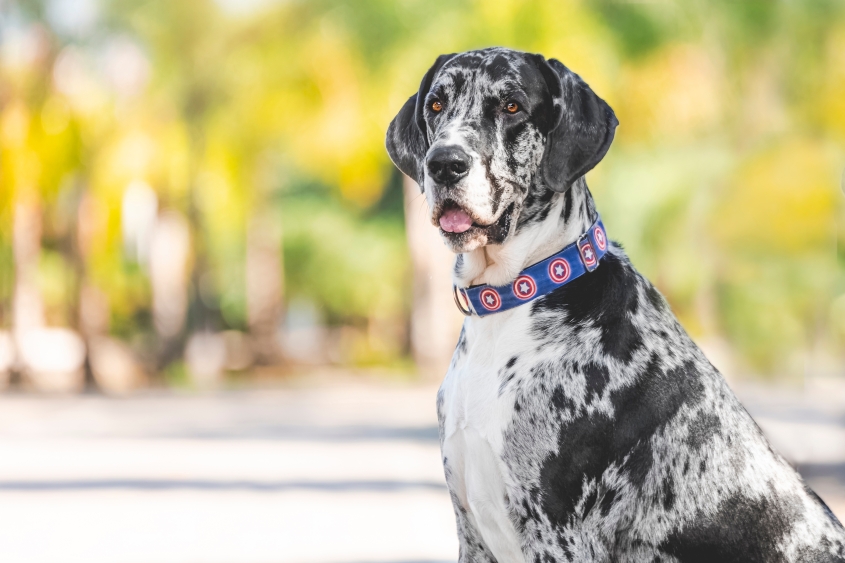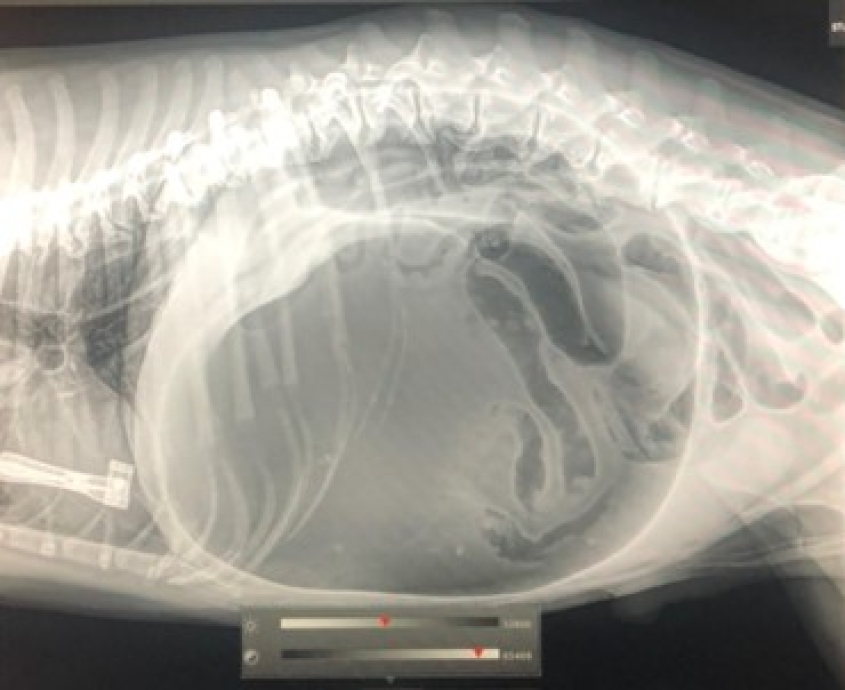Gastric dilatation volvulus (GDV) or “bloat”
Overview
Gastric dilatation-volvulus (GDV) is a life-threatening condition that occurs suddenly when the stomach fills with air, fluid, or food, becomes distended, and twists on itself. GDV requires immediate medical and surgical intervention. Large, deep-chested dogs are most at risk. Preventive measures, such as gastropexy, greatly reduce the risk of this condition.
Cause
GDV occurs when the stomach distends with air, fluid, or food (dilatation, also known as “bloat") and then twists (volvulus), preventing normal stomach emptying and trapping gas. This twisting restricts blood flow to the stomach, leading to tissue damage and systemic complications. The distended stomach compresses major abdominal vessels, reducing blood return to the heart and causing systemic shock and multi-organ dysfunction. It also pushes against the diaphragm, making breathing more difficult. Decreased oxygen delivery to tissues (hypoxia) combined with reduced cardiac output often results in abnormal heartbeats (cardiac arrhythmias). The pressure inside the stomach may cause it to rupture or lead to tissue death (necrosis), increasing the risk of bacteria entering the bloodstream. Additionally, the spleen, located near the stomach, frequently twists along with it, potentially leading to significant internal bleeding.
Risk factors
While there is no single known cause for GDV, several factors may increase the risk of GDV occurring, including:
- Large breed size
- Deep-chested dogs
- A first-degree relative with GDV
- Eating too quickly
- Feeding once daily or a large volume of food per meal
- Older age
- Nervous temperament
- Using a raised food bowl
- Dogs fed dry dog foods that list oils as the first four label ingredients
- Exercising soon after eating
Breed Predisposition
While GDV can occur in any sized dog or breed, it is far more common in large, deep-chested dogs, including:
- Great Danes
- Saint Bernards
- Weimaraners
- Irish Setters
- Standard Poodles
- Basset Hounds
- Doberman Pinschers
Clinical signs
The most common clinical signs may include any of the following:
- Non-productive retching or attempting to vomit with no production
- Excessive drooling
- Panting
- Bloated abdomen
- Painful abdomen
- Restlessness, pacing
- Pale gums
- Weakness or collapse
- “Praying” position (forelimbs extended forward and chest closer to the ground)
Diagnosis
Your veterinarian will recommend blood work and X-rays (radiographs) of the abdomen to confirm a diagnosis of GDV. An ECG (electrocardiogram) is often performed to look for cardiac arrhythmias. Additional testing may be recommended.
Treatment
GDV treatment is initiated with aggressive stabilization of shock with intravenous (IV) fluids. Additional IV medications often include pain medication, electrolytes, lidocaine and antibiotics. Some dogs that experience severe bleeding may require a blood transfusion.
The stomach is decompressed through trocharization, a procedure in which a large needle is inserted through the abdomen into the stomach to release the trapped air. A tube may also be placed from the mouth into the stomach to further empty the stomach; however, a stomach tube may not always pass through the entrance to the stomach.
Once stabilized, prompt surgery is critical to correct the orientation of the stomach and restore blood supply to major vessels and organs. In some cases, part of the stomach or the spleen may require removal if necrosis is present. After the stomach is returned to its normal position, a gastropexy (suturing the stomach to the body wall) is performed to decrease the risk of GDV recurrence.
After surgery, dogs require hospitalization for close monitoring, continued supportive care and early detection of complications such as infections (sepsis) and heart arrhythmias.
Outcome
Early diagnosis and treatment are crucial for a positive outcome. Without medical and surgical intervention, GDV is fatal. The survival rate with medical and surgical intervention is greater than 80 percent. Prognosis may vary depending on the severity of their condition and how long it takes to obtain medical care. Dogs that require removal of the spleen or portions of the stomach may have a more guarded prognosis. Gastropexy reduces the risk of recurrence to as low as 3-5 percent, compared to a recurrence rate as high as 80 percent without it.
Prevention
Since GDV has no single cause, prevention involves several strategies:
- Prophylactic gastropexy: This surgical procedure, often performed at the time of a spay or neuter for at-risk breeds, attaches a portion of the stomach to the body wall. This decreases the risk of stomach twisting, which is the life-threatening component of GDV, but does not prevent bloating.
- Responsible breeding: Dogs with a history of GDV or a first-degree relative affected by GDV should not be bred.
- Feeding Adjustments: Offer two or more meals per day with smaller kibble
- Limit activity after meals
- Avoid raised food bowls
Updated April 2025


